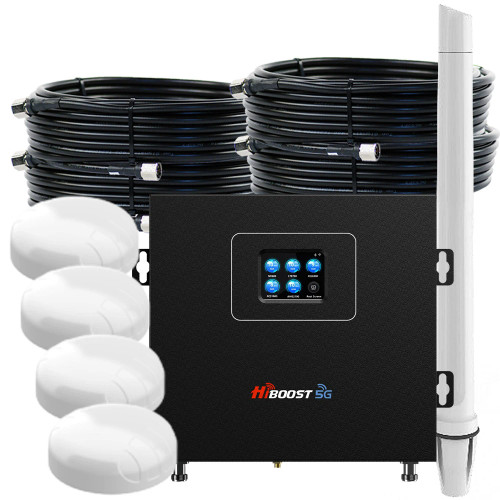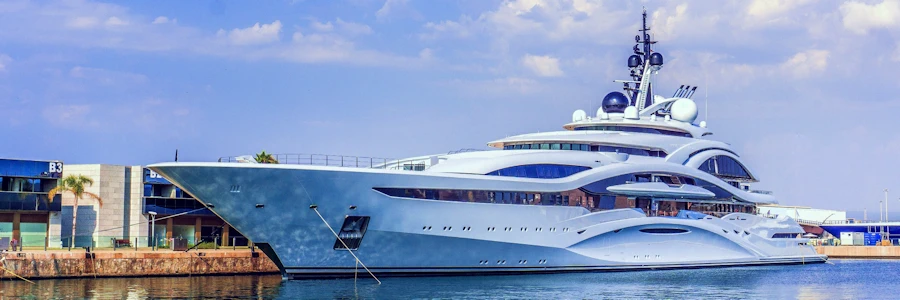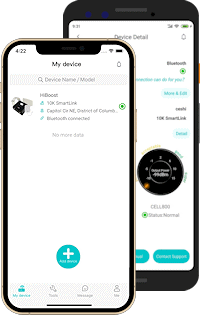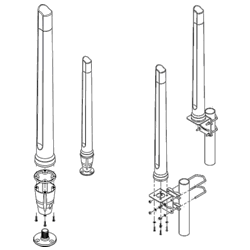


The Europe/Africa/Asia Marine Coastal Cellular Signal Booster improves cellular reception for ships and vessels that are moored and underway. Stay connected throughout your vessel while sailing in coastal waters, in harbors, at anchor, and while docked. Experience faster 5G/4G data and fewer dropped calls, undelivered texts, and missed email messages.
When having a usable cell phone signal in your ship isn’t a luxury, it’s a critical necessity.
This system works with cellular networks that operate on 900 and 1800 MHz frequency bands used in Europe, Africa, Asia, the Middle East, Australia, Oceania, and a handful of countries in the Western Hemisphere (orange countries, below). It also works on 900/1800 MHz networks in countries with mixed frequency bands (blue countries).
This system does not work in countries with 850/1900 MHz networks, including the United States, Canada, and other green countries, below.
With an Ethernet connection, you can monitor, administer, and receive email alerts from your HiBoost Hi23-6s-Plus system from any device with a web browser and internet access. You can also administer multiple HiBoost systems at one or multiple locations.
HiBoost’s Signal Supervisor app for smartphones helps you set up and monitor your cell signal booster. The booster links to your iPhone or Android smartphone via a Bluetooth or WiFi connection. With Signal Supervisor, you can:
HiBoost’s Signal Supervisor app is available for Apple iOS and Android
devices.

The Europe/Africa/Asia Marine Coastal Cellular Signal Booster includes an outside marine antenna for sending and receiving cell signal to and from cell towers.
 The Poynting antenna connects to a 1″ × 14 thread marine mount (left) or to a 3.8–5.0 cm pole (right). (Click to enlarge.)
The Poynting antenna connects to a 1″ × 14 thread marine mount (left) or to a 3.8–5.0 cm pole (right). (Click to enlarge.)
The Poynting OMNI-493 is the right choice if you need a shorter antenna or if you want the best reception for high-frequency cellular bands that have faster data rates. It has 7 dBi of gain on low-band cellular frequencies (617–960 MHz) and 8 to 9 dBi of gain on higher-band frequencies (1710–3800 MHz). Higher frequencies have a shorter range but offer faster data rates, so the Poynting OMNI-493 is the better option if faster data is more important for you than receiving signal at longer distances from cell towers.
The Poynting antenna attaches to a standard 1″ × 14 thread marine mount with an exit hole through which you can run a 30.5 cm TS-195 jumper cable (included) and connect to a 400 coax cable that runs to the booster. The antenna also mounts to poles or posts 3.8–5.0 cm in diameter.
The RFI CDQ7199 is the right choice if you want the best reception for low-frequency cellular bands that have a longer range. It has 8.5 dBi of gain on low-band cellular frequencies (617–960 MHz) and 4.5 to 5.5 dBi of gain on higher-band frequencies (1710–2700 MHz). Lower frequencies offer slower data rates but have a longer range, so the RFI CDQ7199 is the better option if receiving signal at longer distances from cell towers is more important for you than having faster data speeds.
The RFI antenna attaches to a standard 1″ × 14 thread marine mount. It includes RFI’s Q-Fit® threaded quick-release connector for fast, easy takedown and setup for low minimum-clearance passages—the antenna attaches and detaches from its base in seconds. It includes 5 meters of attached RG58 coax cable, which you may connect to the booster with an adapter (included) or attach to a 400-type coax cable to create a longer run.
The Europe/Africa/Asia Marine Coastal Cellular Signal Booster includes four inside antennas for broadcasting amplified cell signal in the compartments in your ship.
 The Poynting PUCK-1 antenna has six mounting options for the greatest flexibility of installation. (Click to enlarge.)
The Poynting PUCK-1 antenna has six mounting options for the greatest flexibility of installation. (Click to enlarge.)
The Poynting PUCK-1 is a small (99.3 mm d × 36 mm h) omnidirectional dome antenna with six flexible mounting options, including magnetic and adhesive bases. It has 4.5 dBi of gain on high-band cellular frequencies (1710–2700 MHz) and nominal gain (−2 dBi) on low-band frequencies (698–960 MHz). It should be mounted to a horizontal surface (like a deckhead) in the center of the compartment where you want to improve cellular signal.
The PUCK-1 has 2 meters of thin RTK031 coax cable, terminating in a 9 mm SMA-male connector that can be easily fed between decks. From there, it attaches to the longer, thicker 400-type coax cables that run to the cell signal booster.
The PUCK-1 is the right choice if you need a small antenna with the most mounting options and the smallest penetration point between the deckhead and wiring conduit.
 The Top Signal EDGE panel antenna can be mounted flush to flat surfaces with the included bracket hardware. (Click to enlarge.)
The Top Signal EDGE panel antenna can be mounted flush to flat surfaces with the included bracket hardware. (Click to enlarge.)
The Top Signal EDGE is a compact (17.5 cm h × 17.5 cm w × 6.8 cm d) directional panel antenna with four mounting options, including a bracket for attaching to walls. It has 4.3 to 5.8 dBi of gain on lower-band cellular frequencies (617–960 MHz) and 7.0 to 7.5 dBi of gain on high-band frequencies (1850–2700 MHz). It should be mounted to a vertical surface (like a bulkhead) and pointed in the direction where you want to improve cellular signal.
The EDGE panel has a 33 cm RG58 coax pigtail cable, terminating in a 15.5 mm N-female connector. From there, it attaches to 400-type coax cables that run to the cell signal booster.
The EDGE panel is the right choice if you cannot attach an antenna overhead or need to project signal across a long, narrow compartment or passageway. It requires a larger penetration point than the PUCK-1 antenna’s SMA-male connector.
The Europe/Africa/Asia Marine Coastal Cellular Signal Booster should be installed by a marine electronics specialist has experience running cable in large vessels. Connecting the antennas and the cell signal booster to the coax cable, however, is relatively straightforward and does not require previous experience.
Click here to download the two-page PDF installation guide for instructions and tips on setting up this system in your boat.
(Learn more about marine antenna mounting options and antenna separation.)
This is a complete kit, with everything you need to start getting the best signal in your vessel.
We’ll gladly customize any of these components to meet your needs; please contact us if you want a custom solution.
All kits include these components:
Kits with the Poynting OMNI-493 antenna kit include:
Kits with the RFI CDQ7199 antenna kit include:
Kits with the Poynting PUCK-1 antenna include 4 of each:
Kits with the Top Signal EDGE panel antenna include 4 of each:
The Europe/Africa/Asia Marine Coastal Cellular Signal Booster system works with major wireless carriers in the Eastern Hemisphere. It also works in the Caribbean and South America with carriers that support 900/1800 MHz cellular bands. (See above.)
It operates on these cellular frequencies:
For information on federal rules governing the use of consumer cell signal boosters, please see our FCC notice page.
 Warning This product can expose you to chemicals, including nickel, which is known to the State of California to cause cancer, and Bisphenol A, which is known to the State of California to cause birth defects or other reproductive harm. For more information go to www.P65Warnings.ca.gov
Warning This product can expose you to chemicals, including nickel, which is known to the State of California to cause cancer, and Bisphenol A, which is known to the State of California to cause birth defects or other reproductive harm. For more information go to www.P65Warnings.ca.gov.
Product Specifications
Warranty Information
For warranty information on this product, please see our HiBoost warranty information page.
Questions & Answers